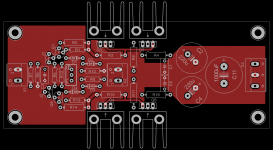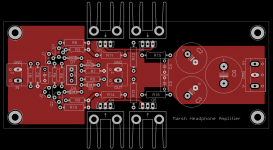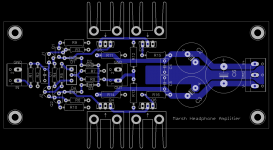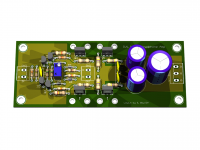Here is something sold by one of the vendors on this site that might work for equalization -
miniDSP
It looks like just the thing to do auto EQ of headphones. Very good price, too.
Thx-RNMarsh
Hi Ryan,
I have already available a +-15V regulated PSU, would this voltage be allright for your amp (I have the semiconductors kit from Jackinnj) or should I reduce it?
I have already available a +-15V regulated PSU, would this voltage be allright for your amp (I have the semiconductors kit from Jackinnj) or should I reduce it?
Unofficially, yes. I run my little guy at +/- 15v. But the devices would be safer operated at +/-12v.
Thx-RNMarsh
Thx-RNMarsh
I used a bench supply at 12v during development and it was just fine there.
I only use 15v for finished amp because it was the easiest to find a high quality regulator circuit pre built. But it stresses the output devices near there max limits and so I wouldnt recommend it to others.
Having said that, try it if you want to. I have not had a failure yet. Just I would be more conservative when recommending to others. The amp doesnt seem to be supply sensitive when it comes to distortion -- whether 12 or 15volts.
-RNMarsh
I only use 15v for finished amp because it was the easiest to find a high quality regulator circuit pre built. But it stresses the output devices near there max limits and so I wouldnt recommend it to others.
Having said that, try it if you want to. I have not had a failure yet. Just I would be more conservative when recommending to others. The amp doesnt seem to be supply sensitive when it comes to distortion -- whether 12 or 15volts.
-RNMarsh
Last edited:
I've used 2SB649AC/2SD669AC for the output devices at higher voltages without failure. The SAO is about the same @15VDC, but ft and gain are higher.
New layout guys, what do you think?
Different approach this time. Following previous advice, it began with small changes and ended with quite a different shape.
I also added optional bypass capacitors, filter cap on the input (220pF), big electrolytic across the rails, and higher bias if needed.
Different approach this time. Following previous advice, it began with small changes and ended with quite a different shape.
I also added optional bypass capacitors, filter cap on the input (220pF), big electrolytic across the rails, and higher bias if needed.
Attachments
OK, I increased a bit the clearance on the supply rails side, but I prefer not to on the signal side, as it would split the ground plane too much. Do you have any reason that you want to widen it more? The clearance is 16mil, which is quite conservative and should not pose any problem for manufacturing.
I renumbered the parts, and added information on the silkscreen.
I will soon send the files to manufacturer for a quote.
Anybody interested can shoot me a PM. Cost for one board should be no more than $6-8 each, possibly lower if several people join in.
If there is enough interest, we could go for high quality 2oz copper PCBs, possibly gold plated.
I renumbered the parts, and added information on the silkscreen.
I will soon send the files to manufacturer for a quote.
Anybody interested can shoot me a PM. Cost for one board should be no more than $6-8 each, possibly lower if several people join in.
If there is enough interest, we could go for high quality 2oz copper PCBs, possibly gold plated.
Attachments
Last edited:
If there is enough interest, we could go for high quality 2oz copper PCBs, possibly gold plated.
My advice -- tinned boards are much easier to work with than gold
I would be interested only if the boards are 2oz copper. No preference for tinned or gold-plated as my iron has no issues with either.
Gold is only used on the traces themselves to protect them. not at the solder joint because gold is quickly leached into the tin/lead and makes for a brittle connection. The solder pads would stay tin or copper.
A solder mask over copper/tin is excellent.
Thx-RNMarsh
A solder mask over copper/tin is excellent.
Thx-RNMarsh
Most board houses offer HASL as a standard plating, lead solder by default, have to specify no-lead if you want that (SMOBC) , extra costs for specials such as Electo-plate or Immersion Gold etc. (SMOGP),tin,silver plate or organic coat (Entek)
I am to understand that they plate nickel over copper before plating gold, this is to prevent leaching of the copper.
Most pcbs end up with around 2oz of copper on outer layers, that is if they have plated through holes, as this plating of copper process adds another oz to the existing cooper foil of 1oz.
Rick
I am to understand that they plate nickel over copper before plating gold, this is to prevent leaching of the copper.
Most pcbs end up with around 2oz of copper on outer layers, that is if they have plated through holes, as this plating of copper process adds another oz to the existing cooper foil of 1oz.
Rick
nickel is plated over copper becuase, as I recall, it is difficult to directly plate to copper without the intermediate metal... it would otherwise tend to seperate, peal off easily....It isnt as durable.
[ Same for chrome plating.... cant chrome directly to steel... use nickel then chrome. Or better, copper then nickel then chrome if you want it to really last. Otherwise, it will peal off.]
In any case, you dont want nickel (a ferrous metal) if you can minimise its use for audio conductor and connectors.
Thx-RNMarsh
[ Same for chrome plating.... cant chrome directly to steel... use nickel then chrome. Or better, copper then nickel then chrome if you want it to really last. Otherwise, it will peal off.]
In any case, you dont want nickel (a ferrous metal) if you can minimise its use for audio conductor and connectors.
Thx-RNMarsh
Last edited:
That'll be news to the periodic table. Nickel is, if I recall, 2 columns over from iron.In any case, you dont want nickel (a ferrous metal)
Mr Marsh likely meant that Nickel is part of what's here called the group of non-noble metals. (aka base metals)
That'll be news to the periodic table. Nickel is, if I recall, 2 columns over from iron.
Not sure what you are arguing about (?). Look into how plating on steel is done and why.
Nickel is wanted for various plating purposes in electronics but not wanted for lowest distortion.
The object of introducing intermediate metals in plating is to close that gap between the base metal and the final metal for reliability of the finished goods. but thats not all.
There are many other details not mentioned about plating and why/what but these are the only ones I am making now.
One example that might be applicable to audio would be durability on contacts... plugs/jacks and edge connectors. When there is a need for a hard metal to prevent wear on repeated insertions. Gold over nickle is another need for a hard base metal. Then there is gold dopping with arsnic to make it hard and not rub/wear off. This is usually what you get with gold... hardened gold. Etc etc etc.
Personally, I would only tin plate the copper or use no plate but only a good solder mask. The fewer the different metals together, the better..... esp. not widely seperated metals on the periodic table.
Thx-RNMarsh
Last edited:
- Home
- Amplifiers
- Headphone Systems
- Marsh headphone amp from Linear Audio




